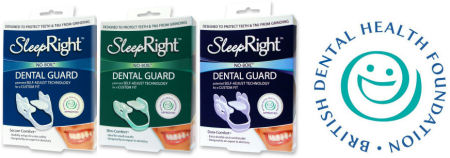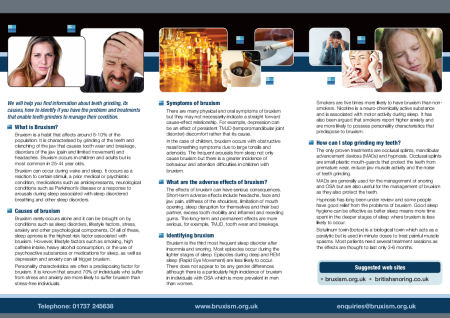Although there have been many other treatments proposed over the years to decrease the level of bruxism, the only proven treatments for bruxism are mandibular advancement devices, hypnosis and occlusal splints.
Occlusal splints are small plastic mouth-guards that can be used immediately without specialist fitting.
Occlusal splints have been found to be the most successful as they protect the teeth from premature wear, reduce jaw muscle activity and the noise of teeth grinding. This means that the user need not worry about ruining their teeth (or any dental work they may have) and their bed partner will not be disturbed by the noise.
There are two categories of occlusal management strategies: 'true' occlusal interventions and occlusal appliances.
Occlusal interventions usually involve occlusal equilibrium, rehabilitation and dental treatment. The treatment is aimed at achieving a 'harmonious' relationship between occluding surfaces. However, there is no high quality evidence to support the use of these irreversible techniques and therefore they are not generally recommended in the first instance.
The most common and effective treatment involves protecting the teeth with occlusal splints. These splints have different names (occlusal bite guard, bruxism appliance, bite plate, night guard), vary in appearances and properties, but in essence, they are all designed to prevent inadvertent tooth movement.
The occlusal splint is the treatment of choice as it reduces grinding noise and protects the teeth from premature wear without substantial adverse effects. Occlusal splints reduce muscle activity associated with sleep bruxism but it must be acknowledged that these devices, like MADs (See Below) for snoring and sleep apnoea, are only a control and will not cure the condition.
MADs are generally used for the management of snoring and sleep apnoea but researchers have investigated their use for the management of sleep bruxism. Many studies report highly effective outcomes in the reduction of sleep bruxism but with undesirable side effects. One study compared the effectiveness between a MAD and occlusal splint. A moderate reduction in sleep bruxism was found with the occlusal splint but a large reduction in bruxism activity with the MAD. This result was difficult to explain but it was hypothesized that because two thirds of the study sample reported pain when using the MAD it may be that with the presence of pain, bruxism activity was reduced.
Psychoanalysis, autosuggestion, hypnosis, progressive relaxation, meditation, selfmonitoring, sleep hygiene and habit reversal/habit retaining have been prescribed for the management of bruxism. Giving an autosuggestion before falling asleep such as 'I will wake up if I grind my teeth' is reported by psychoanalysts to help the bruxist become aware of the habit, even while asleep. Unfortunately, autosuggestion lacks scientific strength and is not recommended.
Hypnosis has long been under review and some bruxists have found profound relief from problems related to sleep bruxism. One study reviewed the long-terms effects of hypnosis and a positive outcome was still applicable even after 36 months. This treatment has promise, and for some it may be successful.
More general relaxation techniques including meditation are supposed to produce a sense of self-esteem and control over one's body. However, there is no current literature regarding the efficacy of this holistic approach to the management of bruxism.
Would you like to receive our most current information and offers by e-mail? Enter your e-mail address here to sign up.

The SleepRight dental guards are the only occlusal splints approved by the British Dental Health Foundation. Find out more.

If you would like us to provide your surgery with our information leaflets, please complete the on-line request form.
Do you need more information for your article or you want to organise an interview? Contact our media desk.

Introducing the world's leading oral appliance for bruxism, snoring and sleep apnoea. Read more.